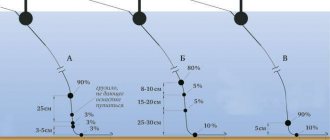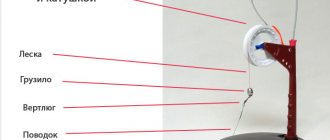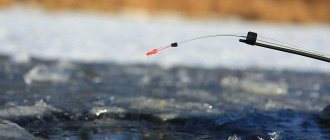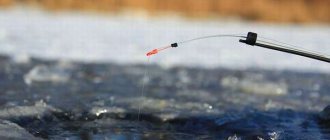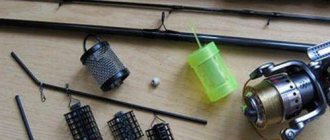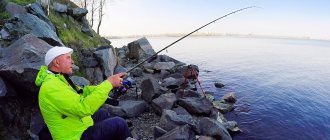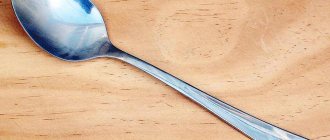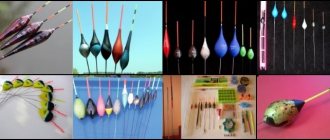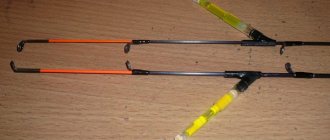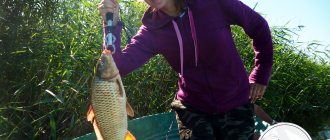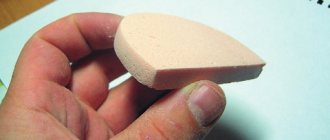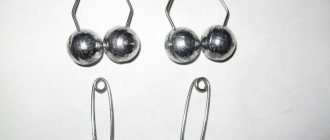Choosing a rod for bottom fishing
Rods for bottom fishing can be classified into three types; they differ in the weight of the equipment:
1. Wand fishing rods are very light, their length is from 1.6 to 2.50 meters, they are equipped with a slow action, the equipment used is light in weight, Wand fishing rods can only be used in standing reservoirs and you can only catch small fish, crucian carp and bream with them.
2. Picker rods are longer from 3 to 3.5 meters, and heavier in weight than Wand, the blank of Picker rods is strong and rigid, quiver tips are used in fishing for bite signals. Quivertips are bent up to 90 degrees, the test weight is from 25 to 180 grams, such fishing rods are used on reservoirs with medium currents, the tip detects the bite immediately.
Pickers are used with maggot feeders so that the food and bait are closer to each other.
3. Feeder donks are used for heavy equipment and have long casting. Large fish are caught with such donks; the donk blank is very powerful and is used in any reservoir in any weather.
Large fish will not be able to fall off the hook due to the very sensitive tip of the blank, which has a soft action.
The following fishing rods are perfect for bottom fishing:
1. Heavy Feeder rods, up to five meters long, are good for fishing in water bodies with fast currents. The form is powerful and heavy.
2. Medium Feeder have a length of 3.5 to 4 meters; these donks are universal; they can be used on any reservoir.
3. Light Feeder is used at short distances in areas of high shrub and herbaceous vegetation, their length is up to 3.5 meters, very light in weight.
As a rule, in the arsenal of an avid fisherman there is not one tackle, but several, and in some cases dozens of tackles. Such fishermen occupy a fairly wide coastal area and set up their gear every five to ten meters.
How to catch perch on a donka?
Perch is not a very neat or cautious fish; ordinary float gear is sufficient to catch it. This predator can also be caught well with a spinning rod, but both methods help in catching only small and medium-sized specimens, and also turn out to be ineffective when fishing in windy currents. During cold periods of the year, during rain and wind, the listed gear is not very effective. To get better results, use a perch donk, which more often allows you to catch trophy specimens, allows you to fish in the current, and make long casts from the shore.
Classic bottom fishing rod
Classic donkey layout with a sliding sinker:
1-sinker with a through hole; 2-limiters; 3-leashes with hooks.
This type of bottom fishing rod is equipped with two leashes, one of which is located below the sinker and is a continuation of the main fishing line, and the other above the sinker. The thickness of the leaders and main line should be selected based on the size and type of fish you want to catch.
Recently, there has been an increase in the popularity of anti-twist agents.
Installation of a donkey with an anti-twist device: 1-plastic tube;
2-spring; 3-clasp; 4-sinker; 5-limiter; 6-leashes.
Despite the variety of shapes and sizes, the principle of their operation is the same - when using a plastic tube, the fishing line does not get tangled when casting, and the leashes do not get tangled. Another advantage of anti-twisters is that they have a clasp to which both the sinker and the feeder can be attached. The convenience of this mount is undeniable, since you can replace the sinker with a feeder in a few seconds.
A design with a “blind” fastening of the sinker to the fishing line is used when leashes are tied above the sinker
When equipped with a donkey with a rubber shock absorber, the following are used:
Donk fishing
Unlike a feeder, which requires the active work of the angler throughout the fishing, donka is a passive method of fishing. That’s why the fisherman always takes several with him. Installs them in a certain area of the reservoir at a distance of three to 10 meters from each other.
Nowadays, with the help of donkeys, they hunt for fish such as large bream, carp or catfish, therefore, after casting the donkey, the angler must take care of its reliable fixation. Most fishermen use coastal bushes or trees for this, placing the bottom on an additional “tuck.”
It is advisable to study the fishing location in advance. Fishermen are advised not to use the bottom in areas of the reservoir with a rocky bottom, snags, branches, or flooded bushes or trees located on the bottom. The donkey will not work well on sharp, steep slopes. It is difficult to control the donkey in reservoirs where the silt layer exceeds 20 cm.
Before casting, the donkey must be unwound to the required length on the shore and laid in rings so that it does not get tangled when casting. Casting can be done in any way convenient for the angler. Most people use the pendulum casting method.
Cloudflare Ray ID: 63a9a0a67a5c10b5 • Your IP: 195.64.208.251 • Performance & security by Cloudflare
You walk along the shore, make stops in promising places and, if there are bites, linger.
How to catch perch on a donka?
Catching perch on a donk means using young fish of peace-loving fish species, which are used as live bait. The predator has a sharp and warlike disposition, so without hesitation he begins an attack on live bait that has attracted his attention. And it is attracted by its activity and the bright color of the live bait.
To catch perch on the bottom with live bait, it is better to use bleak, small crucian carp, gudgeon or roach. The bait must be placed through the upper area of the back near the fin, and to increase its survivability, the hook must be passed through the nostril and its point brought out through the lower jaw.
Feeder equipment for a predator diagram
Donka for perch includes many species, but experienced fishing enthusiasts always choose a jig. They are selected separately, but for muddy water it is better to choose jigs with shine and bright color.
For bait when hunting small fish, you can take maggots, bloodworms, or earthworms.
Rod selection
I don’t think that the running rod deserves the purchase of a separate spinning kit. Unless, of course, you are in the mood to participate in competitions, where success depends on what you fish with . Therefore, for the average fishing enthusiast, an ordinary stick is quite suitable - aluminum or carbon, it doesn’t matter. The main thing is that it meets certain criteria.
I won’t hide the fact that we won’t take spinning rods for twitching and jigging for this type of fishing. The love for these rods is limitless and we cherish and care for them. But in stock there is an old fishing rod, from which the passion for spinning fishing once began.
Why a spinning rod and not a fishing rod? The fishing rod is less versatile in use. Feeder connoisseurs may disagree, but excuse me - this is purely my opinion.
In my understanding, the spinning rod for a running donkey should be:
- Fast.
- Not less than 240 centimeters, but not more than 270 in length.
- Capable of handling loads up to 50 grams.
- The presence of a spinning reel. It’s easier for even a beginner to handle.
With such characteristics of the stick, it is possible to catch fairly large and strong fish at a sufficient distance from the shore.
Many fishermen tried the helicopter, but not all were satisfied. Most people complain about the poor sensitivity of this equipment. There are cases when, after removing it from the water, fishermen observed a leash threaded through the feeder. The helicopter has no other disadvantages, but it has such advantages as attractive bait play in the current and the ability to self-hatch fish.
Rod and reel
Feeder fishing in a fast current has many different difficulties that require a reasonable approach to the choice of such elements of gear as a rod and reel. For fishing from a boat in deep areas, shorter rods are suitable, but when fishing from the shore, the length should be at least 3 meters.
It is advisable to install a high-quality and reliable reel, since a heavy feeder will create a serious load on it. You can use massive models if they do not radically disturb the balance of the feeder gear.
Leash. The fishing rod is equipped with a leash taking into account individual characteristics. At the same time, the main part of the fishing line must not be allowed to overlap with it. For convenient bottom fishing, tackle of more than 18 centimeters is used. If the water inhabitant is large or the current is strong, then this length can be increased, again, everything is selected according to the existing conditions.
Tackle for donkey
At the first stage, you will have to collect bottom gear for fishing in the current.
There are established components for this:
- rod
- coil.
- leash.
- a fishing line with sinkers and fishing leashes with hooks attached to it.
After preparation, donk fishing begins. Some fishermen claim that it is not difficult to create such a structure yourself. You need to work on every element.
Fishing line. Most often this is catching a large predator. Therefore, choose a thick fishing line. It should be more than 0.3 mm, this will allow you not to lose your prey and get a high-quality trophy.
Sinker. For this purpose, a load weight of no more than 100 grams is used. The most suitable shape is teardrop-shaped. If the current at depth is not strong, then a load of up to 50 grams is enough; as the wave appears, this weight increases. Not every weight will resist the fast flow of water.
Leash. The fishing rod is equipped with a leash taking into account individual characteristics. At the same time, the main part of the fishing line must not be allowed to overlap with it. For convenient bottom fishing, tackle of more than 18 centimeters is used. If the water inhabitant is large or the current is strong, then this length can be increased, again, everything is selected according to the existing conditions.
Hook. Basically, the running donka is used for hunting large trophies; accordingly, the hook is selected in a large size. In strong currents, the fish can often escape; to prevent this, experienced fishermen use several hooks or tees at once. Do not forget about the quality of such equipment.
To make it easier to understand this issue, below are all the features of this process depending on the specific season:
How to make a donka with your own hands correctly, fishing for a donka
In this article we will talk about how to make donkey rods for fishing and give the initial knowledge that a novice angler needs to master donkey rods. We will tell you about the usual bottom equipment on a reel, about bottom equipment with a shock absorber, about spinning bottom equipment and installation of equipment that is needed for bottom fishing.
The bottom rod is one of the oldest fishing inventions, having served us for fishing for probably more than a hundred years, and today there is a lot of photo and video material on fishing and equipping a bottom rod. The bulk of fish in our reservoirs feed on all kinds of worms that live in abundance on the bottom, so the main purpose of bottom gear is to catch fish on the bottom.
Classic bottom rigging involves a piece of fishing line wound on a reel, where a weight is attached at the end . A little higher from the weight there are several leashes with hooks.
Typically, this equipment is used for fishing with large baits, because frequent casting requires a lot of experience and creates some inconvenience when fishing.
Due to the high loads on the tackle during casting, thick fishing line is used for bottom equipment, approximately 0.40 mm . Using a strong fishing line will protect the equipment from “shooting” the weight and will give you confidence when fishing for a trophy.
It is best to choose a drop-shaped weight with an eye, weighing 40-120 g. This streamlined shape will facilitate long casting. In ponds without a current, a 40-gram weight is quite enough, but for a current, increase the weight experimentally until the current carries the tackle away.
Leashes should be equipped with a low line breaking load. The size is selected approximately, the main thing is that it is convenient to cast and there is no tangling of the fishing line . Usually on donkeys the size of leashes is no more than 15-25 cm.
Since, as a rule, large fish are caught with this equipment, the hooks, naturally, are chosen quite large, and sometimes doubles are installed.
Donkey hooks must be sharp and of high quality, with the ability to self-hook.
Often several hooks of different sizes are attached to the fishing line, this increases the likelihood of successful fishing.
First, let's say that in a fisherman's arsenal there should be not one equipment and a fishing rod, but several. Often this figure goes beyond a dozen rods . These fishermen usually occupy a very wide area of the shore, and place them every 4-8 meters.
Carp and catfish are considered the main subject of donkey fishing, therefore, when attaching the reel, you must definitely take care of good fixation of the rod so that when you come to check, you do not see an empty place. Often, if a large fish is expected to bite, this fixation is to wrap the rig around a tree.
The area of the reservoir where fishing and fishing will take place must be clear of underwater vegetation and without snags. Any bottom will do except stone . The most effective is night spot fishing, when the donka is placed in places where fish can approach. This may be a lonely tree hanging over a pond, a snag protruding from the pond, bushes near the shore, etc.
Casting is done manually, by swinging a weight, according to the principle of a pendulum. Before casting, you need to unwind the required length of line from the reel, folding it into rings . Then rearrange it in the reverse order so that the tackle throws off the upper ring and not the lower one during casting. These simple steps will help prevent a beard.
In order not to spook the fish when they repeatedly cast the tackle, fishermen tie a piece of elastic to the fishing line; it silently pulls the bait into the pond and absorbs jerks.
Advantages of bottom tackle with a shock absorber:
- delivery of the nozzle to one place;
- silent feeding of the nozzle;
- you can play along with the nozzle;
- you can feed a place with a nozzle;
- you can fish a larger area;
- you can catch small fish;
- More leashes can be attached.
And these are not all the benefits of elastic bands. But the elastic quickly deforms due to prolonged exposure to water. Now about the “elastic band” itself.
This gear consists of:
- main thick line with a cross section of 0.40 mm;
- a fairly long section of fishing line with leashes (3-6 m);
- elastic bands about 8-12 m long;
- a weight on a meter-long nylon cord (to throw);
- insurance from fishing line with a diameter of 0.60 mm.
Difficulties in using this equipment appear only during the first cast. The weight must be thrown accurately and quite far . It doesn't always work out the first time.
If there is a boat, then this difficulty disappears by itself, the weight is brought to the right place. In this case, a foam float is attached to the insurance, which is attached to the weight. At the end of the fishing, we swam up and easily took out the equipment using the safety net.
Before fishing, the main thing is to prepare your equipment . You will have two reels - the first with the main line and elastic, the second with insurance and a leash with a weight. Place them at a distance of 4-6 m from each other and begin to wind them out, counting the number of turns thrown off. Having counted the required amount (for example, 30-50 m), do the reverse steps so that during casting the weight pulls on the upper rings. Use belays a little more than basics with an elastic band.
Important! Never install part of the line with leaders before casting! This section is installed when the equipment is already in the water.
Now we come to connecting the main line, shock absorber and leaders with hooks. All connections are made using a carabiner and swivel.
At the end of fishing, unfasten the carabiner that holds the elastic band and lower it into the water. Then all you have to do is pull the belay and lift the weight out of the water. Unfasten the tackle with hooks and reel everything back to its original form.
The donka from a spinning rod is a truly popular equipment. For one floater there are up to 20 floaters per fishing rod. The feeder, as an alternative to the spinning donkey, is only gaining momentum.
The reel for this equipment can be absolutely anything, even a simple Chinese one. Fishing does not require installing a cord and constant use of the reel ; it will take longer to wait for a bite, so the Chinese reel will last for a long time.
The main fishing line with a diameter of 0.24-0.35 mm is wound onto the reel, and a carabiner swivel is tied to it (we then attach the tackle to it). As you can see, everything is simple.
The first thing that prompted fishermen to create a donkey with a feeder was the ability to cast far and the possibility of spot bait.
Spring
Initially, feeders were made of a spring (hence the name of the gear - spring), into which the bait was clogged. Springs are still used quite effectively in donkeys today.
With these tackles, as a rule, white bream and bream are caught on the river, and when going out for bets, silver carp, carp and crucian carp . By and large, all peaceful fish respond well to this tackle. The only thing a beginner needs is to choose the right bait.
Feeder
Today there is a very large number of feeders in stores, they differ in shape and weight. All feeders are used for different purposes and different fishing conditions. The only thing they have in common is their main purpose - to lure fish. Feeders are more widely used in feeder fishing.
Biting calendar by fishing season
The bream bite at different times of the year varies significantly, which has a tremendous impact on the specifics of catching this fish.
To make it easier to understand this issue, below are all the features of this process depending on the specific season:
- With the onset of winter, bream begins to hide in wintering pits, so the bite stops completely and fishing in December loses its relevance. In January, the activity of the fish gradually returns, but it is still quite sluggish, so bites are very rare. In February, the bite continues to increase, which indicates the resumption of the season.
In January, the greatest chance of meeting bream is on the edges, the depth of which ranges from 6 to 12 meters.
Do you love early spring river fishing as much as I do? Floating ice floes trying to catch the fishing line, grass and debris carried by the current, the water level rising by several meters, because of which it is not clear where to look for fish, is that all? But seriously, right now is the most fertile time for catching trophy whitefish, primarily chub, ide, large roach, dace - fish that still stick to large schools and feed very actively in anticipation of the imminent spawning.
Published 03/01/2019 — 10:58 by alexi87
Do you love early spring river fishing as much as I do? Floating ice floes trying to catch the fishing line, grass and debris carried by the current, the water level rising by several meters, because of which it is not clear where to look for fish, is that all? But seriously, right now is the most fertile time for catching trophy whitefish, primarily chub, ide, large roach, dace - fish that still stick to large schools and feed very actively in anticipation of the imminent spawning.
As a rule, the main equipment for such fishing is a Bolognese fishing rod and a feeder. However, even they are sometimes not able to give the angler the opportunity to successfully fish on a river stream: try fishing here in a pit remote from the shore, when the current carries debris and it is not possible to keep the feeder at the point for longer than 15-20 seconds. The lap dog also remains out of work - it is almost impossible to throw the float at a distance of about 30-35 meters and make clear wiring. We need to think about something!
What is a running donka?
This is where the running donka shows itself in all its glory. Representing, in fact, a symbiosis of a lapdog and a feeder, it provides the possibility of contact fishing at distances of up to 45 meters, without requiring special skills from the angler and, in fact, doing everything for him.
Under this term, in my understanding, the classic feeder tackle is clearly rooted, in which the feeder is replaced by a compact sinker weighing from two to four ounces. It is selected experimentally depending on the strength of the current. With the correct weight of the sinker, the equipment moves along the bottom at a speed that is somewhat slower than the speed of the current.
What gear is used for this kind of fishing?
- The rod is a classic medium class feeder, 3.6-3.9 meters long and weighs up to one hundred grams. But only in the case when fishing is planned exclusively using this method, and the fisherman does not need to throw river feeders weighing 100-120 grams or more. In such a situation, you will have to resort to the help of a heavy feeder or use two tackles, switching between them if necessary. I described how to choose a river feeder in an article of the same name;
- The reel is matched to the fishing rod. In my case, it is a four-thousander with a rear drag and a fine match spool with a gear ratio of 4.8:1;
- The installation is based on a braided cord number 1.0 (conventional diameter 0.1 millimeters), on which a paternoster is knitted as a rig. For such fishing, this installation is universal - the sinker drags along the bottom, while the leash floats slightly above the bottom under the influence of the jet. Exactly as long as your lead arm is;
- The leash has a length of 60-70 centimeters and a diameter of about 0.12-0.14 millimeters, the hook is selected based on the bait used (I have already talked about the most commonly used river baits, the recommendations for a running bottom are similar);
- In addition, the angler should have a supply of tackle that includes several different types of hooks, several skeins of fishing line with a diameter of 0.12 to 0.16 millimeters, as well as a set of sinkers weighing from 1 to 4 ounces in increments of 0.5 ounces (14 grams).
What to take with you when fishing using a walking donkey?
Spring fishing with a running donkey, despite high mobility and frequent transitions from place to place, assumes that the angler can stay in one place for one or several hours. And given that the ground is still frozen, you will need a simple set of equipment and additional accessories.
First of all, we are talking about a compact chair or stool that does not take up much space in luggage and is installed in a matter of seconds, and, being disassembled, will not cause inconvenience during the transition. Secondly, you cannot do without a tripod to install the rod: the butt always lies on the knee, but the whip must be fixed in a static position. You can also use a poke, but only when the ground has thawed and allows you to stick it in.
You also need to think about a bag or backpack that will be used to carry a set of equipment and containers with attachments. Sufficient volume, a large number of external pockets, a comfortable belt or harness for transportation - these are the basic requirements for a high-quality backpack.
Such a set of equipment is quite enough to feel a sufficient degree of comfort without compromising mobility and mobility.
Main types of donks
The history of bottom fishing goes back many thousands of years. This also applies to fishing. In other words, the design of the donka can be considered almost the same age as all of humanity.
The main difference is only that the old fisherman, making a homemade donka, used completely different parts and components. He made them from what he could find near his home. Only a few types of donks have successfully passed the test of time, which will be discussed in this article.
A novice fisherman may not have all the clever methods and tricks that an experienced professional fisherman always uses when assembling a fairly simple but catchy device. This article will describe methods and recommendations that answer the question of how to make a donka with your own hands.
Experts identify the two most popular and effective types of donks:
We also recommend reading:
Gardner loop for a feeder: how to tie Feeder fishing for crucian carp Installation of gear Do-it-yourself bottom gear, production and use How to choose the right feeder for carp fishing
- Donka zakidushka showed itself well when fishing on a river or large reservoir. Its advantage is a fairly long and extremely accurate casting of the bait, which is reflected in its name. But making it yourself will be very expensive. All expenses will be repaid by the fact that it will be quite easy to transfer it to different fishing spots.
- An elastic donka is the most indispensable device for catching crucian carp, bream, perch and other fish that live in freshwater rivers. The main advantage of such a donkey is that it only needs to be cast once at the very beginning of fishing.
